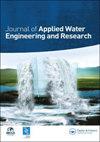电芬顿法处理石化废碱废水除硫
IF 1.6
Q4 WATER RESOURCES
Journal of Applied Water Engineering and Research
Pub Date : 2021-07-08
DOI:10.1080/23249676.2021.1947401
引用次数: 5
摘要
废碱是石油化工工业中危害特别大的废水。它具有复杂的成分混合物,给常规处理工艺带来了问题和困难。在本研究中,研究了电fenton处理作为一种高级氧化工艺(AOP)去除合成废碱液中的硫化物。实验考察了pH、电极距离、电压、过氧化氢(H2O2)浓度和时间等因素对硫化物去除的影响。结果表明,在最优条件下,硫化物去除率可达97%,影响因素主要是反应时间和过氧化氢浓度。有趣的是,当提供足够的反应时间(超过30分钟)时,电极距离和电压的变化被证明是无关紧要的。pH = 5,过氧化物用量大于0.5 mL/L时效果最佳。为了说明各自变量对硫化物去除的相互作用,还进行了统计建模,然后进行了优化和预测分析。采用电fenton法处理废碱。考察了pH、电极距离、电压、H2O2浓度和时间等因素的影响。重要的是,在30分钟内,电极距离和电压变得不显著。在pH值为4.5 ~ 6.5、H2O2浓度为0.45 ~ 0.65 mL/L的条件下,实验结果最佳。在最佳条件下,硫化物去除率达到97%。本文章由计算机程序翻译,如有差异,请以英文原文为准。
Removing sulfide from spent caustic petrochemical wastewater with electro-Fenton treatment
Spent caustic is a particularly harmful wastewater from petrochemical industries. It has a complex mixture of components, causing problems and difficulties for conventional treatment processes. In this study, electro-Fenton treatment was investigated as an advanced oxidation process (AOP) for the removal of sulfide from synthetic spent caustic. The effects of contributing factors such as pH, electrode distance, voltage, hydrogen peroxide (H2O2) concentration and time on sulfide removal were experimentally scrutinized. It was shown that under the optimum conditions, sulfide removal reached 97% and that the most influential factors were reaction duration and peroxide concentration. Interestingly, when adequate reaction times (above 30 min) were provided, changes in electrode distance and voltage were shown to be inconsequential. A pH of 5 and peroxide dosage above 0.5 mL/L were most effective. In order to illustrate the interaction of the independent variables on sulfide removal, statistical modeling was also carried out followed by optimization and prediction analysis. Highlights The electro-Fenton process was used for spent caustic treatment. Effects of pH, electrode distance, voltage, H2O2 concentration and time were studied. Importantly, at t > 30 min, electrode distance and voltage became insignificant. At 4.5–6.5 pH and 0.45–0.65 mL/L H2O2, optimum results are obtained. Under optimum condition 97% removal of sulfide was achieved.
求助全文
通过发布文献求助,成功后即可免费获取论文全文。
去求助
来源期刊

Journal of Applied Water Engineering and Research
WATER RESOURCES-
CiteScore
2.90
自引率
16.70%
发文量
31
期刊介绍:
JAWER’s paradigm-changing (online only) articles provide directly applicable solutions to water engineering problems within the whole hydrosphere (rivers, lakes groundwater, estuaries, coastal and marine waters) covering areas such as: integrated water resources management and catchment hydraulics hydraulic machinery and structures hydraulics applied to water supply, treatment and drainage systems (including outfalls) water quality, security and governance in an engineering context environmental monitoring maritime hydraulics ecohydraulics flood risk modelling and management water related hazards desalination and re-use.
 求助内容:
求助内容: 应助结果提醒方式:
应助结果提醒方式:


